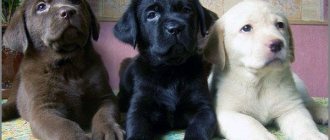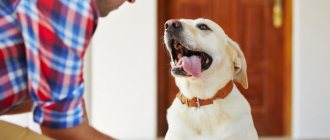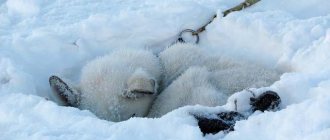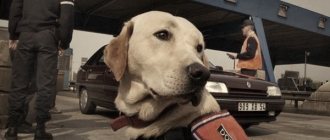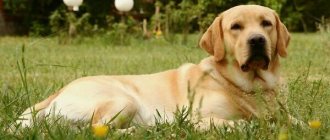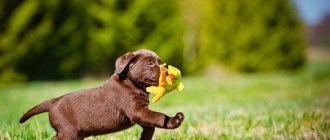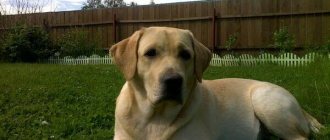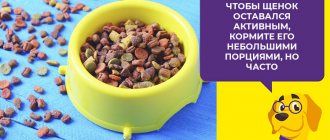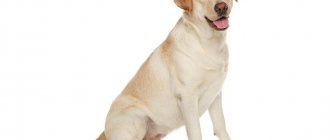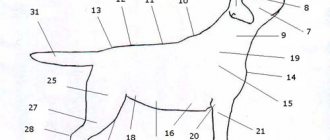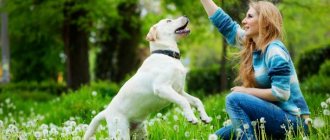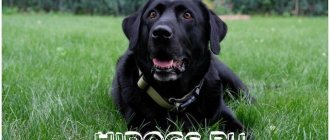What is the breed standard
A dog breed standard, including a Labrador, is a set of characteristics and physical attitudes for an animal that must be preserved for the purity of the breed and the health of the breed.
The standard was approved in 1987 for two varieties of breeds - American and English Labrador. The standard includes not only the exterior, but also the characteristics of the dog’s temperament.
In dog breeding, it is customary to focus on the English standard of the Labrador breed, because it was adopted somewhat earlier than the American one.
The American breed standard is not much different from the English one, this mainly concerns the temperament of the dogs - the “Americans” are more active than the “English”.
Labrador and German Shepherd
Labrador retrievers are beautiful, strong and friendly - the breed is famous for its talents and is very popular throughout the world. The Labradorite phenotype is an excellent foundation for design projects, the basis for new breeding delights. In addition to the Cobberdog already mentioned in the material, there are successful projects of crossing Labras with Spitz, Shar-Pei and Rottweiler.
The most successful mixed release is the “Labroneman”: a cross between a German shepherd and a Labrador .
German half of the project
The German Shepherd is a service dog with a stable temperament and disposition, an active behavioral type, excellent physical condition and training abilities.
Shepherd dogs from Germany are working dogs that are unique in their versatility of use: they are ideally suited for guard, protective, detective and guard duty. German Shepherds are popular in the army, police, border customs, and intelligence services.
The area of professional use of the breed is not limited only to police and security forces: well-trained shepherd dogs are used in livestock farming as shepherds, “flexible animals” are indispensable in social services (guide dogs, canine therapists). German Shepherds make good city family dogs, nannies, tutors, and companions.
Labro foundation
Labradors lead the canine ratings: titles of “most intelligent, friendly, obedient, hardworking... according to professional breeders and experienced owners” are common for English gun retrievers.
The retriever branch has become so widely known, widespread and popular thanks to the amazing combination of exterior characteristics and “working” talents, which allowed Labradors to become not only commercial “gunfighters”, but also simply companions, “toothed workers” of a wide variety of profiles.
Personal aspects
All shepherd dogs are distinguished by intelligence, courage and unquestioning obedience, but hostility in the breed is often “off scale.” Labradors are kind-hearted, world-loving optimists with a complete absence of even a hint of malice.
“ German Service Shepherd ” crossed with a Labrador will compile in its offspring all the original generic qualities: the puppies inherit most of the positive aspects of personality and appearance.
Unperturbed, little emotional and rather “severe” German dogs will receive a soft injection of liberation, playfulness, and sociability. Labrador good-natured optimism, contact and sociability will smooth out the rigidity of the servicemen and soften the Nordic character of the final design “alloy”.
The basic thing should be taken into account: widespread humanism and labrador “familiarity” will not work. German selection has a serious form factor: the Labron German will choose its owner and will obey only him.
The positive advantages of the Labronemese include their peace-loving nature: a mixture of the Labrador Retriever and Shepherd breeds easily adapts to the family hierarchy and easily finds a common language with any domestic animal, from yard chickens to neighbor cats.
The German Shepherd and Labrador mix is easy to train and train. The restlessness, eccentricity and carelessness of the Labras are compensated by the hard work and passion to “serve and protect” the hereditary “police dogs”. Professional coaches speak positively about the ease of training and education of Labronemians, recommending to avoid rudeness and violence in the pedagogical process.
The main differences and characteristics of the Labronemians are their acquired, albeit slightly smoothed out (softened) militancy and readiness to defend themselves at any time. Unlike the “cute” simpletons of Labrov, who are ready to lick and kiss any stranger, designer mestizos are wary of their surroundings, constantly scanning the situation, assessing the level of threats.
What does a dog look like according to the RKF?
- Torso. The Labrador's back line should be straight, the croup should be short and strong. There should be no hunchbacks. Labradors have a wide chest, barrel-shaped ribs, well-defined withers, and a medium-length tail, wide at the base and tapering towards the end. It’s hard to imagine Labradors without such an otter-like tail. It should be located horizontally to the lower back. In the active state, it can be slightly raised, but a crescent shape or bend behind the back is not allowed.
- Head and muzzle. Labradors have a large and massive skull, which stands out a little from the whole image. The cheeks are dry, not fleshy. The muzzle is slightly wide, not too long. Narrow or short is not allowed. The nose is large, with wide nostrils. Labradors' ears are in a hanging position and slightly behind the head. Should not be too long or heavy. The eyes have a friendly and intelligent appearance; only dark shades and medium-sized irises are allowed. The bite is scissor-shaped and the upper jaw completely covers the lower jaw. The neck is dry, long and without folds.
- Front and hind limbs. The general appearance of the limbs is strong and muscular, located parallel to each other. The length of the forelimbs is equal to half the length of the animal at the withers. The pasterns are in the same plane as the forearm, the hock joints are clearly visible.
- Wool. Labradors have short hair, often short. It is hard to the touch, with a dense and dense undercoat underneath. The main feature is water resistance.
Expert opinion Semyon Kirillovich Kozhevin Expert dog handler. Ask a question to an expert “I think the main feature is the tail. This is what they look at, this is due to its specific shape. Another distinctive feature is the ears. They are located as if behind the head. It is also easy to check how purebred a Labrador is by looking at its undercoat. It is especially thick in this breed and also performs water-repellent functions. Well, basically Labradors look like strong and muscular dogs, their movements are smooth, cutting through the air.”
Shade and color
Three shades of color are allowed for Labrador:
- Solid black;
- Pale yellow;
- Chocolate (brown or liver).
Fawn can range from light cream and golden to fox red. It is acceptable for them to have a small white spot on their chest.
Solid color means that the coat should not contain any other color or pigmentation. On the other hand, tan dogs may have a darker back than the rest of their body.
Black Labradors have a different undercoat color - it can be gray or reddish brown. This is due to the fact that any color can have its own shades.
For chocolate-colored Labradors, the tan that sometimes appears on them cannot be considered a solid color.
A dog's color may also change before and after shedding, but only slightly.
Pet behavior
The Labrador's temperament is characterized by the following traits:
- This breed is distinguished by excessive intelligence and intelligence, which is what their look should indicate;
- They always try to be useful to a person, become attached, try to become a true friend for them;
- Get along equally well with adults and children;
- They have a high level of learning ability, because of this they are easy to train and amenable to education;
- They are friendly, kind and non-aggressive. Aggression is a disqualifying sign.
Can a dog change as it ages?
Like any other creature, your Labrador's behavior and appearance can change with age.
This is most evident in changes in character traits.
Aging Labradors now perceive separation differently; they become susceptible to separation from their owner and react to it especially acutely. When meeting, they can be violent, rejoicing at the return.
They also become less receptive to commands, and their activity decreases.
You can also notice changes in their appearance - they look haggard, move slower than usual, and their fur becomes more faded.
Crossbreed options
Currently, quite productive breeding work is being carried out to create mixed breeds of retrievers and other dog breeds. Below are descriptions of the external and behavioral characteristics of various Labrador mixes.
With shepherds
Labrador and Shepherd mixes are fairly large dogs that come in a variety of colors. Adults weigh approximately 45-50 kg. To obtain a mixed breed, German, Caucasian or East European shepherd dogs are chosen.
Labrador/German Shepherd mix
Labrador and shepherd mixes are quite active, playful and good-natured animals. Such pets will make excellent companions. After all, due to their timidity, they are not able to perform security functions.
Dogs will need to be fed special hypoallergenic food, since these animals are prone to allergies to certain foods, as well as indoor plants.
With a Dalmatian
Externally, mixed breeds of a retriever and a Dalmatian resemble spotted Labradors. True, they weigh a little less. In addition, nature has endowed such dogs with longer limbs.
Representatives of a crossbreed are usually distinguished by the following character traits:
- smart,
- unperturbed,
- charismatic,
- friendly.
They harmoniously combine the qualities of a guard and a companion.
How to distinguish a Labrador puppy from a mixed breed
It will not be difficult for an experienced owner to distinguish a Labrador from a mongrel, but beginners in this area may have questions:
- Any manifestation of aggression, even in a puppy, should alert you: Labradors do not have this quality.
- Labrador puppies have a slightly larger head than the rest of their body. They are somewhat robust, with medium-sized eyes, and their noses are not elongated or pointed.
- The ears should be completely hanging and not too long. Located behind the head.
- Another distinctive feature is the tail, similar to that of an otter.
- Dense coat, thick undercoat. It should be somewhat harsh to the touch, even for puppies.
- The color is solid, without spots or pigmentation. Only a white spot on the chest is allowed.
Pay attention to the puppy's behavior.
He should be active, but at the same time listen to your words. The look is conscious, interested and friendly.
How to determine if a puppy is a purebred Labrador
There are 3 main indicators of this breed:
- wool,
- tail,
- facial expression.
When standing, the dog must be well balanced. The tail is straight. It is thick at the base and should taper towards the middle.
Labradors have a wide head, the transition from the forehead to the nose is well defined, and the eyes are set far apart.
Even a small puppy’s coat should not be sparse, the outer layer should be hard and even rough to the touch, the undercoat should be dense, but soft and silky.
What should be most confusing is the lack of undercoat or very long hair. If so, most likely you are not looking at a purebred Labrador.
Labrador puppies video:
Labrador Retriever
The Labrador Retriever is a very active and agile large dog with a strong build. Labradors are very intelligent and easy to train. They love to fetch objects. Dogs of this breed are very active and require sufficient exercise. Labradors come in three colors: fawn, black and chocolate. The fawn color can range from light, almost white to cream and bright red. The character of these dogs is friendly; Labradors are absolutely devoid of aggression. They will not be able to protect the owner if something happens, so they are not a guard. Labradors easily find contact with people of all ages and adore children. This is a wonderful companion dog. They also love to swim, they have webbed feet that help them move quickly in the water, and an otter-like tail that acts as a rudder in the water.
Chocolate Labrador with a puppy
Golden Retriever (Golden)
The Golden Retriever is a dog with a balanced character, calmer than the Labrador Retriever and has longer hair. Golden retrievers range from light, almost white, to bright red. Dogs of this breed are distinguished by grace, beauty, they are very friendly and welcoming. The coat is thick and long, so this dog is not very suitable for people who are allergic to wool. In this case, a Labrador is a more suitable breed. Goldens are very versatile dogs; just like Labradors, they can be taken hunting, they also love to swim, and these dogs are often used in the rescue service of the Ministry of Emergency Situations.
Golden Retriever
Flat-Coated Retriever (Flat)
Flat is an active, strong dog of medium build, self-confident. The character is good-natured and friendly. Flat-coated retrievers are very smart, they are easy to train, have a strong nervous system, but unlike other retrievers, they are more sensitive. Therefore, with flat trading you need to be more restrained and patient. Flats come in two colors: brown (liver color) and black. The coat is thick and of medium length. Flats need long walks and sufficient physical activity. Flat-Coated Retrievers do not require much grooming. It is necessary to periodically comb the fur with a brush or furminator and, as with other lop-eared dogs, they need to clean their ears once a week.
Flat-coated retriever (flat)
Chesapeake Bay Retriever
The Chesapeake Bay Retriever was bred to work in difficult weather conditions in the water and hunt waterfowl. This breed of retriever is better suited to working in cold water than others. Unlike other retrievers, this is a more serious dog with a strong-willed character. The Chesapeake Bay Retriever is devoted to one owner and is monogamous. This is one of the few retrievers who have a developed protective instinct and distrust of strangers. The dog must be socialized from an early age to avoid the development of aggression. The Chesapeake Bay Retriever comes in colors ranging from all shades of brown, grass-grass (straw) to golden red. Due to its dominant nature, the Chesapeake Bay Retriever is not suitable for beginners or people who have no experience with large dogs.
Chesapeake Bay Retriever
Curly Coated Retriever (Curly)
Curly is a strong and independent dog, smart, friendly, and self-confident. It comes in black and brown colors and has curly fur. Unlike other retrievers, curly-coated ones are less sociable and can give the impression of being withdrawn. Curly is one of the few retrievers who are capable of guarding. They are wary of strangers and can show aggression in case of danger. This breed of retriever is not very popular in Russia. They are mainly distributed in England, Australia, the USA and Canada. The dog is stubborn and self-confident, so for people who have no experience in training large dogs, the Curley is not suitable. This category of retrievers is not recommended to be kept in an apartment. Their desirable content is in a fenced yard where the dog can move and run freely.
Curly Coated Retriever (Curley)
Nova Scotia Retriever (Toller)
This breed of retriever was developed in Nova Scotia. It was originally used to attract waterfowl. The dog is medium-sized, powerful, compact. They are significantly smaller in size than other retrievers. Their height at the withers is 47 - 51 cm, males, females - 45 - 49 cm. Weight: males - 20 - 23, females - 17 - 20 kg. The Nova Scotia Retriever comes in one color - red with white spots on the chest and paws. Tollers are reserved and hardy. They have a need to fetch objects, which makes them indispensable in their work. Unlike other retrievers, tollers are a little more difficult to train. Training should be varied, as they cannot stand monotony. In a family, the toller usually chooses one owner. Distrustful of strangers. In Russia, tollers are not yet so popular; they are difficult to find.
Nova Scotia Retriever (Toller)
How to choose a thoroughbred?
- Buy a puppy not “from hand”, but from nurseries and boarding schools that specialize in breeding them;
- Check the puppy's pedigree through a special database. There you will see his parents too;
- The puppy's appearance should be well-groomed and well-fed. There should be no discharge from the eyes, mouth or ears, the stomach should be free of rashes and not swollen;
- Look at the parents and ask the breeder in more detail about them: where they were exhibited, what titles they have, if the conversation goes well, then you can even ask for the relevant documents confirming his words;
- Look at the puppy's documents. They should contain information about the registration, his parents, the brand number that matches the one on the puppy;
- Check with the vet. a passport where all vaccinations given to him should be recorded;
- Compare the puppy with the standard indicators.
NOTE! If you want to purchase a real purebred Labrador, you will have to spend a long time studying all the documents that the breeder provides and be extremely attentive to the details and his words.
How to choose a mixed-breed puppy
Many even experienced dog breeders say that there is no single formula and purchasing a dog is always a lottery. At the same time, it is still worth focusing on a few simple rules so as not to get into trouble.
- It is better to buy a puppy from a specialized nursery or from experienced breeders. The market, no doubt, will be cheaper, but the quality of the animals, their physical condition and documents leave much to be desired. There are often cases of purchasing a cute puppy from the market with a bunch of additional sores, which will subsequently upset all family members. In addition, the breeder can tell you a lot about the puppy’s habits and the peculiarities of caring for this particular breed of dog.
- The dog must have a special puppy card with all the marks from the veterinarian. It is best to wait a little and pick up the animal with all its vaccinations. This will allow you to protect yourself and your new pet. If the chosen dog is a club and purebred dog, it should have a brand inside the ear and on the inner thigh. The brand, of course, should not be drawn with a marker; this is obvious fraud.
- It is better to pick up a puppy when it reaches 7-8 weeks. Externally, the dog should be well-groomed and well-fed. Eyes, nose, ears must be clean. The abdomen is clean without rash.
- Pay attention to the pedigree, mother and father of the puppy. Labrador is one of the most beautiful show breeds, and even if owners do not initially think about it, many later come to this idea. Do not hesitate to ask to show you photographs, tell in detail about what exhibitions your parents participated in, what prizes and titles they received.
Before choosing a puppy, you need to determine why a person gets a dog:
- If you need a guard and protector, you should pay attention to crosses with German shepherds, Alabais, Dobermans and Rottweilers.
- For those who want to find a loyal friend, consider mixed breeds with companion breeds like the Dalmatian.
- When crossed with miniature dogs - dachshunds, corgis, beagles - the same compact mestizos are obtained, which are excellent for apartment living.
We suggest you read: The cat is walking, how to calm it down at home, what to do, medications and folk remedies
Regardless of their origin, puppies should be friendly and balanced. It is advisable to get to know their parents - pets born from overly aggressive dogs should not be purchased. It is recommended to play with the animal a little to understand what kind of character it has.
The babies will look more like a Labrador puppy, but they should show the traits of a different breed.
The Labrador Retriever mix will become everyone's favorite pet and devoted companion. But when choosing a puppy, you need to remember that the genes of the parents can manifest themselves in completely different ways.
But is it really necessary to know the breed of your dog if these devoted eyes are looking at you?
The dog is ready to follow all your orders. It doesn't matter what color or size it is.
After all, the main thing is that she be your true friend. No one knows whether such mixtures of breeds will ever be recognized.
Now there are more and more organizations that create special clubs. They help owners properly raise their mestizo, as well as train him.
For a long time now, people abroad have treated mestizos as equals. They don't consider anyone better or worse.
Europeans began to approach this issue from a pragmatic side. Each purebred dog has its own shortcomings, and the mixed breed takes the best for itself.
Labrador retriever and children
One of the main reasons why Labradors are still the number one breed in many countries is that they are the best friends for children of any age, even the youngest. Because this breed has an excellent reputation based on its friendliness with people of all ages, Labradors get along best with children. If you want to have a truly friendly family with a dog, then the Labrador will be a chic choice that will give your children a lot of unforgettable pleasant hours. Research has shown that Labradors are very similar in character to children - they constantly have great enthusiasm, friendly curiosity and sincere kindness. Due to the fact that this breed loves to eat and play more than anything else, your children will be able to spend a lot of time with the dog, receiving only the most pleasant sensations. And, since Labradors are very gentle, you do not have to worry about the health of your children. In addition, this breed has a very developed parental instinct, which allows dogs to sense when a child is doing something wrong and warn him against bad things. Labradors love to spend time outside, in nature, which will allow your children not to sit all day in front of the TV or computer, but to fully develop while walking with their dog. Activities such as hiking, swimming, catching a plate, or a ball are perfect. Children will definitely get involved in such a healthy lifestyle, which will definitely have a positive effect on them. In addition, Labradors look very menacing and will be able to protect your child from any ill-wisher. It is no secret that many Labradors during their lives have saved a huge number of people who found themselves in unforeseen circumstances. Thanks to the presence of a Labrador in your family, children will better learn to express their feelings to loved ones, become more cheerful, kind, frank, which will ultimately have a wonderful effect on relationships throughout your home. And thanks to the fact that Labradors are highly trainable, you can easily arrange a real serious task for your child - training, which he will do with great pleasure. When buying a Labrador for yourself, you can be sure that he will provide an unforgettable childhood for all your children, constantly giving them pleasant and simply unforgettable experiences.
Take a look at our forum, where there are many threads dedicated to this topic. For example, the theme of Labrador and child
The Labrador Sea is the northernmost body of water in the Atlantic; its waters were formed 40,000,000 years ago after the separation of the island of Greenland from the mainland of North America.
Mixed Labrador and Shar Pei
One of the rarest breed combinations for a crossbreed, as it is in the initial stages of crossbreeding.
But already in a few individuals you can notice a funny structure that resembles a Labrador with folds.
You should not expect that the puppy will be the size of a Labrador, but at the same time completely covered with folds. Most of them will be present on the face in the form of “jowls”.
The adult size will be larger than a Shar Pei , but smaller than a Labrador .
It is also worth noting the resistance to diseases that are inherent in one of their breeds. Why is this happening? A gene from one breed suppresses a disease characteristic of another.
Character
If you think that a dog will be guaranteed to protect you, then this is a mistake.
A mixed breed is an excellent guard only if the genes of the Shar Pei succeed the genes of the Labrador.
But what cannot be taken away from the character is love for the owner and devotion. Don’t forget to help your dog socialize, as the Shar Pei gene can significantly hinder your pet’s ability to do so.
General description of the Labrador Sea
The Labrador Sea has free access to the waters of the Atlantic and is also adjacent to the Baffin Sea through the Davis Strait. In addition, through the Hudson Strait there is access to the bay of the same name. The water area also includes several other bays that require special attention: Humberend, Hamilton, Ungavu, Chore and Saglek.
Labrador can confidently be called an oceanic interisland sea, which is part of the Atlantic Ocean. In addition to the aforementioned Greenland, the boundaries of the water area pass through islands such as Newfoundland and Baffin Island. The Labrador Peninsula is also of particular interest.
It is by the name of this peninsula that the sea is named Labrador.
The sea is also in close proximity to the Arctic Ocean.
Labrador Sea on the map
— —
Bottom relief of the Labrador Sea
The bottom of the reservoir, as a rule, consists of rock of igneous nature. The reason for its appearance lies in the great activity of once active volcanoes. The relief has a highly dissected shape. As for the shelf, it extends in a fairly wide strip, reaching a length of up to 250 km.
The development of relict forms related to the glacial relief is also observed here. Closer to the shores, there are a huge number of various shallows, reefs and depressions. In the south-eastern side the relief decreases. In some areas there are underwater canyons.
Shallow water extends throughout the entire coastal zone. The coastline is quite indented, and this can be seen if you look at the map. Fjords are not uncommon in these places. Most of the nearby islands are covered with steep cliffs. Some of them are located near the shore.
The Labrador Basin with a very unique relief form is formed by the seabed. The average depth is about 1900 m. As for the maximum values, here they reach 4000 m.
Pros and cons of mestizos
This breed has a huge number of both positive and negative aspects. Let's look at these sides.
Positive:
This is a mixed breed, which means it can be purchased for a small fee or even free. This means you will save a significant amount of money.
Mestizos adapt very quickly to the new environment. They do not need a huge amount of time to get used to certain living conditions.
Such dogs will quickly and easily learn all your commands..
They have high immunity to various diseases. The owners of such dogs spend less on expensive medications, and their pets live longer.
If one of the breeds that was crossed had a tendency to certain ailments, then the mestizo will not have this.
As for nutrition, they do not have to buy expensive food. They can easily tolerate natural food.
Minuses:
- have no pedigree or documents; have shortcomings in external data; cannot participate in various international dog shows.
Hydrological regime of the Labrador Sea
The proximity of the Arctic has a huge impact on the climatic regime of the reservoir. This is one of the seas of the World Ocean, which has a rather harsh subarctic climate, and icebergs are found in this area throughout the year.
The reservoir is covered with floating ice even in summer, and the surface of the water usually gets rid of it only closer to August. Even on hot days, surface water temperatures struggle to reach +70C. In cold times, the structure of the water is quite uniform and its temperature remains in the range of 0.5-0.70C.
The hydrological regime of the Labrador Sea itself is ambiguous due to the cold and warm currents passing through it, as well as northern air masses. The relative proximity to the Davis Strait affects not only the water temperature, but also its salinity.
A decrease in temperature is usually observed in the direction from south to north. For a given water area, the most significant changes are those that are observed throughout the entire area and in different areas, rather than with increasing depth.
The salinity of the reservoir is directly dependent on the East Greenland Current and decreases in the direction from south to north. In winter, its average reaches about 34‰. Closer to the shores, this parameter decreases slightly, reaching 33‰. With increasing depth, the salinity of the water either decreases, then increases again, and then levels out at around 34-34.5‰.
As for currents, there are several of them in the Labrador Sea. For example, the North Atlantic Current contributes to a slight warming of sea waters, while the Labrador Current brings with it cold waters. Tides in the open sea, with rare exceptions, exceed 2 m in length. In some cases this figure reaches 4 m.
There are no large rivers in the water area, and those small reservoirs that exist cannot have a serious impact on salinity indicators.
Flora and fauna of the Labrador sea
The diversity of flora and fauna is approximately the same as in other Arctic seas. But in this area of the Atlantic Ocean there are also more thermophilic species living in the southern part of the sea. In the summer season, schooling fish and squid live here.
Phytoplants, which are represented by red, brown and green algae, are found in large quantities. Bird representatives include guillemots, gulls and other seabirds living in the rocks. Among the bottom invertebrates there are organisms such as mollusks, shrimp, crustaceans, sea worms, etc.
The sea is also home to whales, killer whales, beluga whales and dolphins. As for fish, there are quite a lot of them in these places. Flounder, gobies and sculpins are most often found near the shore. In addition, several species of herring and sharks are found in the Labrador Sea.
